
Browse an alphabetical list of film clips that feature important events before, during, and after the Holocaust and World War II. These clips include home movies, propaganda films, newsreels, and more.
<< Previous | Displaying results 51-100 of 191 for "Film" | Next >>
After the trial of major war criminals before the International Military Tribunal in Nuremberg, the United States held a series of other war crimes trials at Nuremberg during the Subsequent Nuremberg Proceedings.The ninth trial of these proceedings, before an American military tribunal, focused on members of the Einsatzgruppen (mobile killing units) who had been assigned to kill Jews and other people behind the eastern front. This footage shows US Supreme Court Justice Robert Jackson, chief prosecutor for…
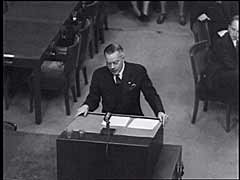
After the trial of major war criminals before the International Military Tribunal in Nuremberg, the United States held a series of other war crimes trials at Nuremberg—the Subsequent Nuremberg Proceedings. The ninth trial before the American military tribunal in Nuremberg focused on members of the Einsatzgruppen (mobile killing units), who had been assigned to kill Jews and other people behind the eastern front. In this footage of the prosecution's opening statement, US prosecutor Ben Ferencz explains…
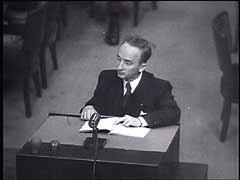
After the trial of major war criminals before the International Military Tribunal in Nuremberg, the United States held a series of other war crimes trials at Nuremberg—the Subsequent Nuremberg Proceedings. The ninth trial before the American military tribunal in Nuremberg focused on members of the Einsatzgruppen (mobile killing units), who had been assigned to kill Jews and other people behind the eastern front. This footage shows US prosecutor Ben Ferencz outlining the purpose of the trial during…
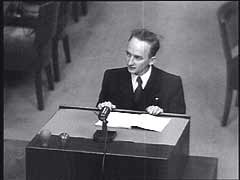
Estonian auxiliary forces assisted the German Einsatzgruppen (mobile killing units) in the mass killing of Jews and others during World War II. Ralf Gerrets and Jaan Viik were both members of the Estonian security police during the German occupation. This footage shows them during their trial, on charges of war crimes, in the Estonian Soviet Socialist Republic. The Estonian Supreme Court found both guilty and sentenced them to death in 1961.

Delegates of 32 countries assembled at the Royal Hotel in Evian, France, from July 6 to 15, 1938, to discuss the problem of Jewish refugees. The refugees were desperate to flee Nazi persecution in Germany, but could not leave without having permission to settle in other countries. The Evian Conference resulted in almost no change in the immigration policies of most of the attending nations. The major powers--the United States, Great Britain, and France--opposed unrestricted immigration, making it clear…
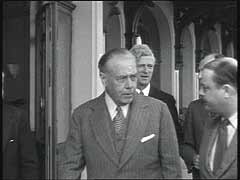
The Hadamar psychiatric hospital was used as a euthanasia killing center from January until August 1941. Nazi doctors gassed about 10,000 German patients there. Although systematic gassings ended in September 1941, the killing of patients continued through the end of the war. In this footage, American soldiers supervise the exhumation of the cemetery at Hadamar and begin the interrogation of Dr. Adolf Wahlmann and Karl Wilig, who participated in the killings.
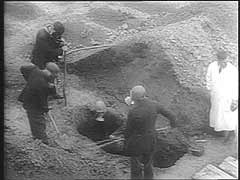
Germany invaded the Netherlands on May 10, 1940. Four days later, German planes bombed Rotterdam. The Germans tried to halt the raid on the city because Dutch authorities had agreed to negotiate the surrender of their country. However, a communications failure delayed the order halting the attack. The bombing destroyed much of the city center, leaving almost 80,000 people homeless. The Netherlands surrendered just a few hours later. On May 15, in retaliation for the bombing of Rotterdam, the British air…
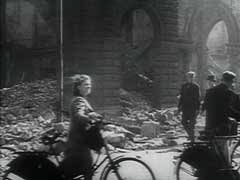
German troops reached parts of Warsaw on September 8 and 9, 1939. During the German siege of Warsaw, the city sustained heavy damage from air attacks and artillery shelling. Warsaw surrendered on September 28. Here, German troops occupy Warsaw. This footage comes from "Tale of a City," a film made by a Polish underground film unit.
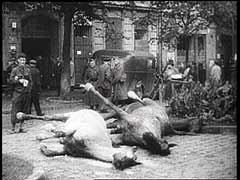
Father Charles E. Coughlin was a Catholic priest who reached a large audience through mass rallies and radio broadcasts. Coughlin, openly antisemitic, was an outspoken critic of the political establishment. This footage shows him addressing more than 80,000 people, the Illinois members of the National Union for Social Justice, at Riverview Park in Chicago. He criticized President Roosevelt (running for a second term as President of the United States) and attacked the government's fiscal policy in the…

Japanese forces took the Philippine islands between December 1941 and May 1942. After US naval victory in the Battle of Midway (June 1942), Allied forces slowly gained naval and air supremacy in the Pacific war. In October 1944, US forces began the liberation of the Philippines. The campaign on Luzon, largest and most northern of the islands, began in December 1944. This battle footage shows many Japanese soldiers being taken as prisoners of war.

Jubilation over the liberation of Paris: US troops parade along the Champs-Elysees and French civilians celebrate. General Charles de Gaulle and General Omar Bradley review the troops.
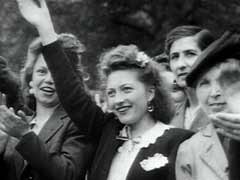
The Junkers (Ju) 87, known as the "Stuka," spearheaded the Blitzkrieg ("lightning war") attacks that were decisive in the western campaign in 1940. Stuka dive-bombers closely supported German ground forces. They destroyed enemy strong points, aircraft, and airfields, and spread panic in rear areas. Although slow and easily shot down by Allied fighters, the Stukas proved devastatingly effective in the German invasions of Poland and western Europe, where Germany enjoyed superiority in the air. Stukas caused…
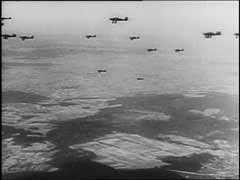
The German-Soviet Pact of August 1939 included a nonaggression pact whereby Germany and the Soviet Union promised not to attack one another for 10 years. Germany was thus able to invade Poland on September 1, 1939, without fear of Soviet intervention. In accordance with secret provisions of the pact, Poland was partitioned between Germany and the Soviet Union. Soviet forces occupied eastern Poland. In this footage, German and Soviet forces meet along the Bug River in central Poland. Less than two years…
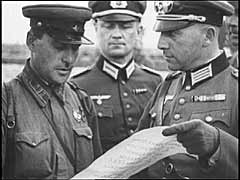
US forces liberated the Buchenwald concentration camp in Germany in April 1945. Here, US soldiers escort German civilians from the nearby town of Weimar through the Buchenwald camp. The American liberating troops had a policy of forcing German civilians to view the atrocities committed in the camps.
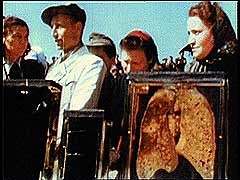
Germany invaded Poland on September 1, 1939, beginning World War II. German forces swiftly overran Polish border defenses and approached Warsaw, Poland's capital city. Warsaw suffered heavy air attacks and artillery bombardments during the campaign. The city surrendered on September 28. This footage shows German forces entering Warsaw amidst the destruction caused by their bombardment of the city.
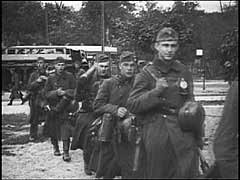
Allied forces occupied most of Germany by the end of April 1945. German forces fighting in Italy were the first to surrender unconditionally to the Allies. Representatives of the German command in Italy signed the surrender on April 29, and it became effective on May 2, 1945. Five days later, on May 7, 1945, Germany surrendered unconditionally to the western Allies, ending the war in Europe.
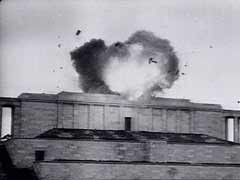
Germany invaded France in May 1940. This footage shows German tanks, artillery, and divebombers attacking the Maginot Line, a series of French fortifications intended to protect France's border with Germany. The main German assault, however, went to the north through Luxembourg and bypassed the Maginot Line. German forces entered Paris on June 14, 1940. Little more than a week later, defeated France signed an armistice with Germany.
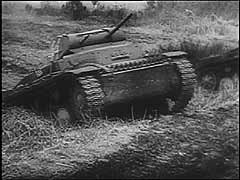
Germany invaded Norway on April 9, 1940, simultaneously attacking Norway's coastal cities from Narvik in the far north to Oslo in the south. Despite Allied naval superiority, German naval forces played an important role in the campaign. This footage shows German naval units sailing towards Norway in rough seas. German victory in Norway secured access to the North Atlantic for the German navy, especially the submarine fleet, and safeguarded transports of Swedish iron ore for Germany's war industry.
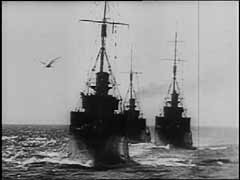
Germany invaded Norway on April 9, 1940, simultaneously attacking Norway's coastal cities from Narvik in the far north to Oslo in the south. Narvik was the scene of fierce battles between German forces and the Allies, who landed troops by sea in support of the Norwegians. Narvik changed hands several times. However, British, French, and Polish forces were finally withdrawn in June 1940 due to the success of the German campaign in western Europe. German victory in Norway secured access to the North Atlantic…
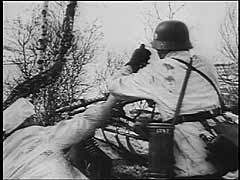
France signed an armistice with Germany on June 22, 1940, recognizing the right of German authorities to oversee the French administration. Further, German military authorities held jurisdiction over matters of internal security. In this footage, a German military court in Paris tries French citizens charged with resisting measures of the military occupation. Despite harsh military justice, the Germans could not quell opposition in France, and resistance activities would reach a peak during the Allied…

Germany launched its western offensive on May 10, 1940. German paratroopers landed in the Netherlands on the first day of the German attack on that country. They seized key bridges and fortifications, compromising Dutch defensive positions. This footage shows the German air force (Luftwaffe) dropping paratroopers near Rotterdam. Within days, the Netherlands was defeated. The country surrendered to Germany on May 14. The Dutch government and Queen Wilhelmina fled to exile in Great Britain.
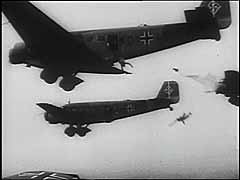
Denmark signed a nonaggression pact with Germany in 1939, hoping to maintain neutrality as it had in World War I. Germany, however, broke the agreement on April 9, 1940, when it occupied Denmark. King Christian X remained on the throne, and the Danish police and government reluctantly accepted the German occupation. This footage shows the German presence in the occupied Danish capital, Copenhagen. In 1943, as German policies towards Denmark toughened, the Danes would form one of the most active and…
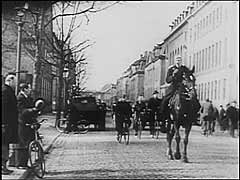
Germany invaded Poland on September 1, 1939. The Blitzkrieg ("lightning war") campaign in Poland was short and decisive. Warsaw, the capital of Poland, surrendered on September 27. In early October, Adolf Hitler visited Warsaw to review his forces. This footage shows victorious German army units parading before Hitler in the streets of the devastated city.
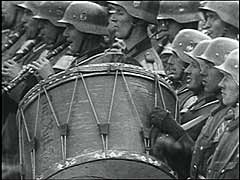
On the night of November 14-15, 1940, almost 500 German bombers attacked the British industrial city of Coventry in central England. The bombers dropped 150,000 incendiary bombs and more than 500 tons of high explosives. The air raid destroyed much of the city center, including 12 armament factories and the historic Saint Michael's Cathedral. This footage shows scenes from the aftermath of the attack. The bombing of Coventry came to symbolize, to Britain, the ruthlessness of modern air warfare.
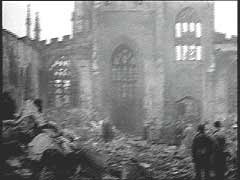
Germany invaded Poland on September 1, 1939, beginning World War II. Quickly overrunning Polish border defenses, German forces advanced towards Warsaw, the Polish capital city. This footage from German newsreels shows German forces in action during the invasion of Poland. Warsaw surrendered on September 28, 1939.
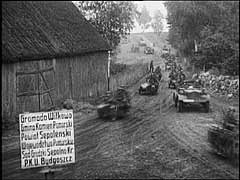
Adolf Hitler's foreign policy aimed at establishing a European empire for Germany through war. This policy required the rapid expansion of Germany's military capabilities. The Geneva Disarmament Conference, beginning in 1932, sought to avoid another European war by negotiating a reduction in armaments. Hitler repudiated this effort by withdrawing Germany from the conference in October 1933. At the same time, he rejected collective security in international affairs by withdrawing from the League of Nations.…
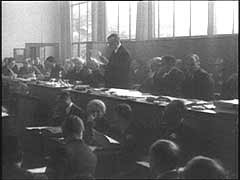
This footage shows Joseph Goebbels, Nazi minister for propaganda and public education, speaking at the September 1935 Nazi Party Congress in Nuremberg. In the speech, Goebbels--a fanatic antisemite--linked Bolshevism with international Jewry and warned Nazi party members of an alleged international Jewish conspiracy to destroy western civilization. Goebbels led the purge of Jewish and other so-called "un-German" influences from the cultural institutions of Nazi Germany.
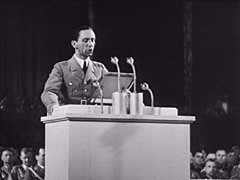
In this German propaganda newsreel, the former Mufti of Jerusalem, Hajj Amin al-Husayni, an Arab nationalist and prominent Muslim religious leader, meets Hitler for the first time. During the meeting, held in in the Reich chancellery, Hitler declined to grant al-Husayni’s request for a public statement--or a secret but formal treaty--in which Germany would: 1) pledge not to occupy Arab land, 2) recognize Arab striving for independence, and 3) support the “removal” of the proposed Jewish homeland in…
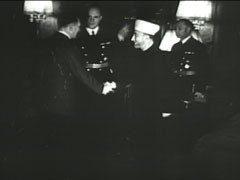
This film clip shows the use of headphones at the International Military Tribunal. English, French, Russian, and German were the official languages of the Nuremberg trials. Translators provided simultaneous translations of the proceedings. Each participant in the trial had a set of headphones.
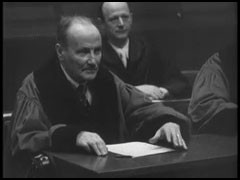
Nazi supporters parade at a campaign rally in Waldenburg, Germany. In a speech, Hitler attacks the Weimar Republic and pledges to dissolve the parliamentary system soon after he gains power.
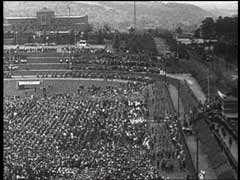
Hitler speaks before the Reichstag (German parliament). Amid rising international tensions, he tells the German public and the world that the outbreak of war would mean the end of European Jewry.
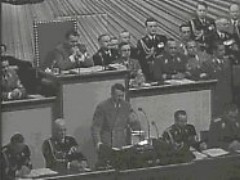
In this German newsreel footage, Hitler addresses members of the SA and the SS in the Sportpalast, a sports arena in Berlin, Germany. He thanks them for their support and sacrifice during the Nazi struggle for power.
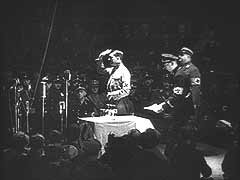
One day after France signed an armistice with Germany in June 1940, Adolf Hitler celebrated the German victory over France with a tour of Paris. Here, Hitler's train arrives in Paris. Hitler's tour included the Paris opera, the Champs-Elysees, the Arc de Triomphe, and the Eiffel Tower. After visiting Napoleon's tomb and the Sacre Coeur, Hitler left Paris. In all, Hitler spent about three hours in the city. In July, Hitler returned in triumph to Berlin, Germany.
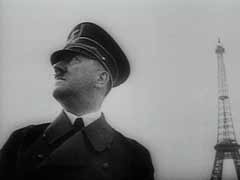
The German army (Wehrmacht) regarded the war in the east as a crusade against communism and not subject to the "normal rules" of war. After the German invasion of the Soviet Union in June 1941, Soviet soldiers followed a "scorched earth" policy to hinder the German advance. In this German newsreel footage, German soldiers approach a burning village, one of many destroyed during the invasion of the Soviet Union.
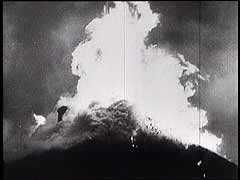
Marshal Ion Antonescu was ruler of Romania from 1940 to 1944. Following the defeat of German forces at Stalingrad, Hitler suspected that some of the countries allied with Germany intended to negotiate a separate peace. In this German newsreel footage, Antonescu meets with Hitler in Berchtesgaden, Germany, primarily to reassure Hitler that Romania remained committed to the German war effort. In the year following this meeting, King Michael of Romania arrested Antonescu and signed an armistice with the…
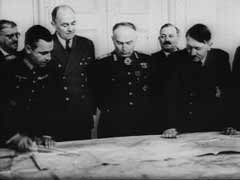
While Japanese diplomats in Washington, DC, negotiated with Secretary of State Cordell Hull, Japanese planes bombed the naval base at Pearl Harbor. American outrage at the surprise attack overcame isolationist sentiment and the United States declared war on Japan the following day.

World War II in the Pacific theater ended with the Japanese surrender on September 2, 1945. The surrender was signed in Tokyo Bay aboard the American battleship USS "Missouri." Foreign Minister Shigemitsu headed the Japanese delegation. General Douglas MacArthur accepted the surrender on behalf of the Allies. Admiral Nimitz signed for the US and Admiral Fraser for Britain. Representatives of all the Allied nations attended the signing.

In the 1930s, famous Tennessee jazz musician Valaida Snow was known as “Little Louis” because her talent with a trumpet rivaled the legendary Louis Armstrong. She performed around the world, but it was a tour of Europe that would haunt her for the rest of her life. While in German-occupied Denmark, Snow is said to have been arrested and imprisoned in Copenhagen. It is still unclear why she was arrested or what was done to her while she was held, but after her release in a May 1942 prisoner exchange,…
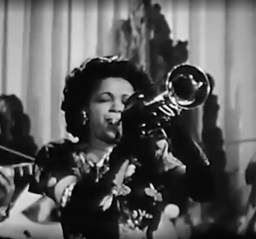
Soldiers of the Jewish Brigade, British Eighth Army, in the Faenza area of Italy. The Jewish Brigade took part in the final stages of the Allied offensive in Italy.
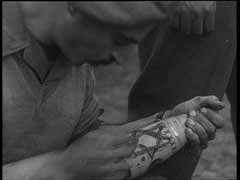
Beginning in 1941, the Germans deported Jews in Germany to the occupied eastern territories. At first, they deported thousands of Jews to ghettos in Poland and the Baltic states. Those deported would share the fate of local Jews. Later, many deportation transports from Germany went directly to the killing centers in occupied Poland. In this footage, a German propaganda unit films recent arrivals from Magdeburg, Germany, in a collection center run by the Jewish council in the Warsaw ghetto. In July 1942,…
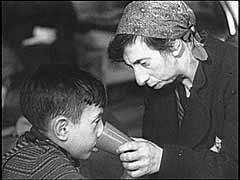
The ship "Henrietta Szold," carrying more than 500 Jewish "illegal" immigrants from Greece to Palestine, arrived in Haifa on August 14, 1946. British authorities immediately interned the immigrants and deported them to British internment camps on the island of Cyprus.
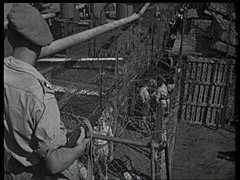
The postwar movement of about 250,000 mainly eastern European Jewish survivors to displaced persons camps and to the West, with the goal of reaching Palestine, was known as the "Brihah" ("flight"). Here, Jewish refugees cross illegally into Italy, probably to charter a ship to sail to Palestine. The British restricted Jewish immigration into Palestine and deported "illegal" immigrants to detention camps in Cyprus.
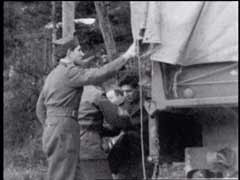
After the Munich agreement and the Czech surrender of the Sudetenland to Germany, German authorities expelled these Jewish residents of Pohorelice from the Sudetenland to Czechoslovakia. The Czech government, fearing a flood of refugees, refused to admit them. The Jewish refugees were then forced to camp in the no-man's-land between Bruno and Bratislava on the Czech frontier with Germany.
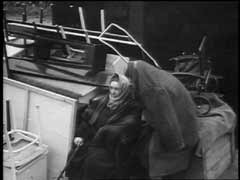
US forces liberated the Dachau concentration camp in Germany in April 1945. Here, survivors of the camp stand during the singing of "Hatikva" ("Hope") before Rabbi David Eichhoren, a US army chaplain, leads one of the first Jewish prayer services after liberation.
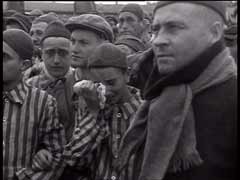
Shortly after the German occupation of Belgrade, Yugoslavia, in April 1941, the Germans forced Jews to clear the rubble caused by the heavy bombardment of the city. This German newsreel footage shows Jews clearing some of the rubble. Most of the city's Jews were later arrested and interned in camps. The German army later shot the Jewish men in retaliation for Serb resistance; the Germans killed the Jewish women and children in gas vans. Only about 2,200 Jews of Belgrade returned to the city after the war.
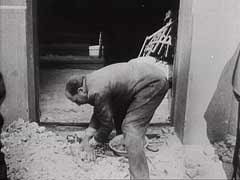
Julius Streicher, Nazi leader and publisher of the antisemitic newspaper "Der Stuermer" (The Attacker), makes a speech accusing Jews of trying to control the world and living by the exploitation of non-Jews. According to Streicher, the only answer for Germany is to solve the "Jewish question."
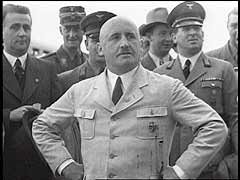
Japanese pilots used the tactic of Kamikaze (suicidal) dive-bombing attacks on enemy warships in 1944 and 1945. The "USS Nevada," despite an escort and efforts to fight off a Kamikaze attack, sustained such a hit in early 1945 off the coast of Japan. The "USS Ticonderoga," a carrier, also sustained such a hit in early 1945 off Formosa (Taiwan). The impact of Kamikaze attacks decreased during the final months of the war in the Pacific, in part because of an improvement in Allied evasion tactics.
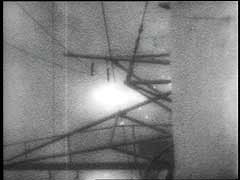
Upon arrival in the Auschwitz camp, victims were forced to hand over all their belongings. Inmates' belongings were routinely packed and shipped to Germany for distribution to civilians or use by German industry. The Auschwitz camp was liberated in January 1945. This Soviet military footage shows civilians and Soviet soldiers sifting through possessions of people deported to the Auschwitz killing center.
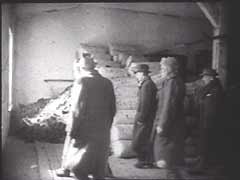
Soviet military footage showing children who were liberated at Auschwitz by the Soviet army in January 1945.
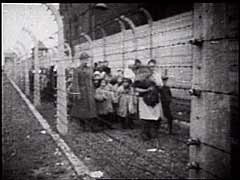
Soviet troops entered the Auschwitz killing center in January 1945 and liberated thousands of sick and exhausted prisoners. This Soviet military footage was filmed shortly after the camp was liberated. It shows Soviet doctors examining victims of sterilization, poisonous injection, and skin graft experiments.
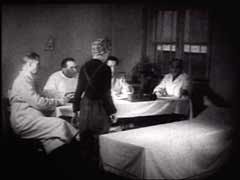
We would like to thank Crown Family Philanthropies, Abe and Ida Cooper Foundation, the Claims Conference, EVZ, and BMF for supporting the ongoing work to create content and resources for the Holocaust Encyclopedia. View the list of donor acknowledgement.